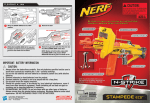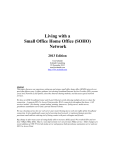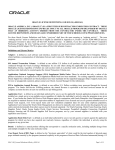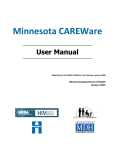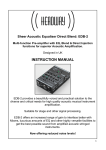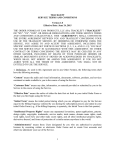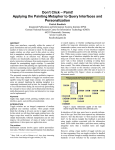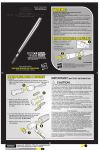Download Trademarks and Domain Names
Transcript
CHAPTER Trademarks and Domain Names 4 No one was ever fired for buying IBM. —Anonymous This chapter is about brands, the words and symbols that identify the source of products and services. A strong brand can help bring customers to your products and services. Brands provide credibility. Building and implementing legal protection for your brand are essential ingredients in the success of a digital technology business. The legal name for a brand is a trademark. IN THIS CHAPTER This chapter covers the following topics, all from a software, Internet and digital technology perspective: ■ Introduction to trademark law ■ Strong and weak trademarks ■ Trademark priority ■ Trademark searches ■ US trademark registration ■ Trademarks around the world ■ Trademark licensing ■ Trademarks on the Internet 61 62 CHAPTER 4 Trademarks and Domain Names ■ Domain names ■ Trademark disputes WHAT IS A TRADEMARK? You have an everyday sense of trademarks that identify companies as the source of goods and services—such as Microsoft, Apple, IBM, and Intel. You know that trademarks also apply to particular products—for example, an Excel spreadsheet, an iMac computer, an Electronic Arts video game, or a Core2 Duo processor. Trademarks for products and services appear on screen displays, on packaging, in advertising, on Web sites, and in computer manuals. A trademark can consist of: A name like Microsoft. A slogan like EA Sports’ “It’s in the Game!” Letters and/or numbers like AS/400, an IBM computer hardware brand. A design or logo like Apple Inc.’s various apple-shaped logos. A sound like the familiar Yahoo! yodel sound. Trademarks are source identifiers that carry an emotional charge. They can be conservative and safe, for example, IBM’s brand WebSphere. They are sometimes quirky like Google or hip like Java. They can come in families, like iTunes, iPod, iLife, iPhoto, iPhone and iMac. Selecting good brands is an art. Many digital technology products have more than one trademark; for example, Symantec, the Symantec logo and pcAnywhere are all trademarks of Symantec Corporation and all are used on pcAnywhere products. A trademark can also be used to show one company’s component in another product. An example is the famous “Intel Inside” logo and sound. Service marks are trademarks that apply to services. Companies that provide online services such as software-as-a-service vendors use service marks. So do service Web sites such as online travel services, auction sites, or dating services. Other digital technology businesses that use service marks include developers, contract programmers, data recovery services, data and media conversion services, and system integrators. (For convenience, we will refer only to trademarks or just use the term “marks”; aside from some details of the procedure for registration, the rules for service marks are the same as trademarks.) What is a Trademark? 63 Countries around the world protect trademarks under their national law. (In the European Union (EU), one “Community Trade Mark” or “CTM” registration can cover all 27 member countries.) While this chapter is primarily about US federal trademark law, some important international aspects of trademarks are discussed later in this chapter. In the United States, trademark rights may arise under both federal and state law. The federal trademark statute is called the Lanham Act. Generally speaking, the Lanham Act will apply with regard to trademarks used in US interstate or international commerce. We will discuss state trademark law only in passing in this chapter. Because most digital technology and software companies have interstate (and international) operations, they rarely bother with state trademark filings. Domain names are different from trademarks of course, but they overlap with trademark law because they also can serve as important identifiers of products and services. (There are some cases where domain names are also trademarks; for example, Salesforce.com is a trademark of Salesforce.com, Inc.) You will find a discussion of the legal rules that apply to domain names later in this chapter. Trademark Goals Brands are built through smart selection, advertising, public relations, and promotion (including Web promotion) and labeling of products. When a brand helps close a sale or allows a company to charge a premium price, the investment in branding pays off. From a legal perspective, your goal should be to create a “trademark space” that defines your products, services, and company now and for the future. That means companies should: ■ Get a strong and defensible trademark or family of trademarks. ■ Have protection for the trademarks in every market in the world where the brand is used. ■ Be proactive in trademark protection, so that legal protection is secured not only for existing product brands and product types, but for product extensions and not only for current geographic markets, but for future sales territories as well. ■ Actively exclude others from using confusing similar trademarks in each relevant product market. 64 CHAPTER 4 Trademarks and Domain Names We recommend that every technology company think long and hard about its brands and review its branding strategy periodically. Product development and branding should be coordinated. Companies need to allow for the time required to select a protectable brand and, if needed, secure the corresponding domain names. Trademark registration should be secured in all relevant markets in time for launch of each new branded product and service. If you want to have a family of marks (like the iTunes, iLife, iPhone series), apply for them in advance. If your company properly establishes and protects its trademarks, the law can be a powerful tool to stop competitors from using or blurring the name and reputation that it has established. When you sell your company, its value will be much greater if it has a well-known and legally protected brand. Trademark Risks Bad things can happen if you neglect trademark law. For example, if you do not take proper steps under trademark law: ■ You could introduce a new product and be forced to withdraw it until you change its branding. ■ A competitor could start eroding your business and confusing customers by using your trademark or one that looks confusingly similar to your trademark. You might not be able to stop it from doing so. This chapter will help you avoid these disruptive results. Company Names vs. Trademarks Company names (also known as “trade names”) may often be very similar to trademarks, but they are not the same. For example, “Sun Microsystems, Inc.” is a company name. The United States Trademark and Patent Office site has a trademark search function that shows that Sun has more than 150 trademarks registered in the United States. These trademarks include: Solaris, Sparc, Java, Sun, and Sun Microsystems. However, “Sun Microsystems, Inc.” is not claimed as a trademark. When a company has a main trademark that is used across a line of products or services, such as “Sun,” “Nokia,” or “Motorola,” it is commonly called a “house mark.” What is a Trademark? 65 Scope of Legal Protection Here, in one sentence, are the two concepts at the heart of American trademark law: the law generally protects the owner of a distinctive trademark that has priority. ■ A distinctive trademark is one that is capable of distinguishing one company’s goods from other similar goods made by someone else. ■ Priority, generally speaking, goes to the first user of the trademark in the relevant market or the owner of a trademark registered with the US federal government. The law gives such an owner a remedy in court when someone else, without permission, uses the same or a similar trademark if customers are likely to be confused about the source of the goods or services. Let’s now take a closer look at these two concepts. Distinctiveness of Trademarks Trademark law protects only distinctive marks. Broadly speaking, the more distinctive the trademark, the better the legal protection. Why does the law emphasize distinctiveness? The answer is that the law seeks to balance trademark rights on one hand with the freedom to use ordinary language on the other. For example, only one software business needs to label its goods “Symantec,” but many businesses legitimately need to label a program a “Utility.” Symantec therefore is a strong trademark, and “Utility” is a generic term that has no trademark protection at all. In order to understand how to choose a trademark, or how much protection an existing trademark can get, you have to understand what makes a trademark more or less distinctive—what separates trademarks into “strong” marks and “weak” marks. We are talking here about legal strength, recognized in a court of law. Generally speaking the stronger (that is, the more distinctive) your trademark is, the easier it is to get strong legal protection for the trademark in court and the easier it is to get federal registration. Two Kinds of Distinctiveness The law in fact recognizes two types of distinctiveness. The first is based on inherent distinctiveness. This means using brands consisting of words and symbols that look and sound distinct when applied to a particular kind of goods. “Apple,” for 66 CHAPTER 4 Trademarks and Domain Names example, sounds distinctive when applied to a computer, music player, or software although it would be generic when applied to pies or jam. The second type of distinctiveness is based on secondary meaning—that is, the power that a trademark gets when many customers have come to recognize it. Secondary meaning is also called acquired distinctiveness. A rule of thumb often used in the law is that a trademark in continuous use for five years is presumed to have secondary meaning, but there are exceptions. In this mass-media age, recognition can possibly come in a few weeks through intensive advertising and public relations. “Windows” is a good example of a word that has acquired distinctiveness in the software world through use. At one time a software “window” was simply a screen or part of a screen in which content might be displayed; now of course it is distinctively associated with Microsoft operating system products. Strong and Weak Marks Strong marks are good. When you go about choosing a trademark or evaluating the inherent strength of an existing trademark, you need to know how the law classifies trademarks. There is a ranking based on how inherently distinctive types of marks are. As mentioned, the more distinctive, the stronger the trademark; the less distinctive, the weaker the trademark. Here are the categories: Arbitrary Marks—An arbitrary trademark is one that bears no logical relation to the goods that it labels. Examples are coined marks, like Xerox, eBay, or Symantec, or marks with meaning wholly unrelated to the function of the product, like Apple, Adobe, or Amazon. Arbitrary marks have the strongest inherent distinctiveness. Suggestive Marks—A suggestive trademark is one that suggests but does not describe a product’s function. Examples are Autodesk (for design and drafting software), iTunes (for an online music store), Intuit (for financial software), and VeriSign (for encryption and security products). None of these marks states what the products do, but each product trademark suggests what the product line does. Suggestive marks are also strong, but not as strong as arbitrary marks. That is because similar products can justifiably have similar names. For example, another online music store could justifiably include the word “tunes” in its brand. Descriptive Marks—A descriptive trademark primarily describes (as opposed to suggests) the characteristics of a product, such as its performance, function, What is a Trademark? 67 features, quality, or capacity. An example is Virusafe anti-virus software. Some marks are more descriptive than others. For example, marks such as “Calendar Maker” or “Business Plan Maker” are deemed very descriptive and therefore legally very weak marks. In general, descriptive marks are weak. If marks are wholly descriptive, trademark law protects them only if they have acquired significant secondary meaning. Surnames as Marks—Common family names as trademarks are weak, and like descriptive marks, will often be protected only if they have acquired secondary meaning. Norton (anti-virus software) would be an example of a surname that has this kind of acquired distinctiveness. Surnames can be more distinctive if unusual or used in association with other words or in a distinctive design. Place Name Marks—Place names also make weak marks and normally will have protection only if they have secondary meaning. The trademark will be a bit stronger if the place name is less well known. Generic Marks—Generic marks identify a category of goods recognized by an industry. For digital technology products, this would include the terms Works, Draw, Database, Graphics, OS (for operating system), Utilities, and so forth. These marks are the weakest. By themselves they have no protection at all. However, it is possible sometimes to protect the combination of words that is generic in part but has a nongeneric component, for example: Microsoft Works, Norton Utilities, or CorelDraw. Under US trademark law, if a generic term is given a novel spelling, it is nonetheless generic. Rules of Proper Trademark Use Sometimes trademarks that were originally distinctive become generic because they come to be identified not as a trademark for a product but with the product itself. Examples of common words that started out as trademarks are aspirin and dry ice. Because aspirin and dry ice are now generic, any company can call its acetylsalicylic acid “aspirin” or its frozen CO2 “dry ice.” So when a trademark becomes generic, it loses all protection and anyone can use it. Lawyers refer to this as genericide. Genericide applies in the digital technology world. A federal court in California ruled in 1991 that “386,” a variant of Intel’s 80386 brand for a family of microprocessors, had become generic and could therefore be used by AMD, a competing maker of compatible microprocessors. This is one reason that Intel switched to arbitrary marks like Pentium and Centrino. 68 CHAPTER 4 Trademarks and Domain Names How do companies stop genericide? Here are some often quoted guidelines: ■ Use the trademark together with the product description and make the trademark look different, such as “AppleWorks Word Processing Program” or “AppleWorks Word Processing Program.” ■ Do not use the trademark in the possessive. Avoid “AppleWorks’s features.” ■ Don’t use the trademark as a noun or a verb; always use it as an adjective. For example, refer to “Microsoft Excel Spreadsheet Program” rather than “Microsoft Excel.” ■ Always use a trademark notice (see discussion later in this chapter on these notices). There is a problem with these rules as commonly prescribed. They are just too cumbersome to follow religiously. For example, think how the Microsoft Excel user guide would read if Microsoft had to add the words Spreadsheet Program every time it used the word Excel. What many companies do with these rules in real life is compromise. The first page of the Excel User Guide may have the words Spreadsheet with Business Graphics and Database, but the text just refers to the product as Excel, using the trademark as a noun. Most software companies reach the same type of compromises and have avoided genericide. Carelessly casual use of trademarks is still a risk. The bottom line is that every advertisement, piece of packaging, and manual should make it clear to the reader that your trademark is a trademark. Confusingly Similar Marks Preventing customer confusion regarding the source of goods and services is the cornerstone of trademark law. Trademark law protects a distinctive trademark with priority against other companies that are using marks that are confusingly similar— that is, marks that cause customer confusion about the source of the goods. This means that you may be sued if you adopt or are using a trademark confusingly similar to another distinctive trademark that has priority over your mark. (Principles of priority are discussed in detail below.) Similarly, you may have a litigation remedy if someone else adopts a trademark that is confusingly similar to yours, but only if you have priority. Use of a trademark that is confusingly similar to a trademark that has priority without permission constitutes trademark infringement. What is a Trademark? 69 Deciding When Two Marks Are Confusingly Similar How do courts decide if marks are confusing similar in infringement lawsuits? There are a variety of relevant factors: ■ Fame of the priority trademark (judged based on sales, advertising, length of use) ■ Whether the priority trademark is strong or weak ■ Similarity or dissimilarity of the marks in appearance, sound, connotation, and commercial impression ■ Similarity or dissimilarity and nature of the goods or services ■ Number and nature of other similar marks in use on similar goods ■ Similarity or dissimilarity of trade channels ■ Conditions under which, and buyers to whom sales are made, for example, “impulse” sales where risk of confusions is high vs. careful planned purchasing ■ Nature and extent of any actual confusion—or the length of time during, and the conditions under which there has been concurrent use without evidence of actual confusion ■ Variety of goods on which the priority trademark is used Applying these factors to decide whether a trademark is confusingly similar to another is normally a matter of common sense, based on the facts of the situation. For example, if you choose as your software trademark “Orracle” or “Microsof,” it is a good bet that you will be sued and will lose. Customers or potential customer could be confused. You can also run into problems if part of your trademark is the same or similar as prior trademark. On the other hand, if the field of use of two marks is very different, the same or similar marks may not be confusingly similar. An example of this principle is the trademark Lexis, which is the name of a database service for law firms owned by Mead Data. In 1989, Mead Data sued Toyota Motor Co., trying to prevent Toyota from using the trademark Lexus for its luxury automobiles. Mead lost the case, because the judge decided that the field of use of the two marks was just too dissimilar. (Different rules apply, however, for “famous” trademarks. This topic is discussed below.) 70 CHAPTER 4 Trademarks and Domain Names Distinctiveness in Selecting a Trademark You should apply the concepts discussed above to select a new trademark. A trademark will have the best legal protection if it is arbitrary or suggestive. Most of the marks that are powerful in the computer field have those characteristics. Strong marks such as Sun, Cisco, Intel, Oracle, and Apple are examples. Often new companies are inclined to choose marks that tell the consumer what the product does, which means that they will select a weak trademark like Virusafe. Short-term marketing reasons support this type of choice. However, the price for picking a weak trademark is that competitors may be able to enter the market with products bearing quite similar names. In general, lawyers consider that it is best to choose a strong trademark—particularly for your company’s principle brands. Choosing good new marks for technology companies is not easy. That is because there are many tech companies with many brands already. In addition, many companies want the brand and a domain name to be the same, and that may be difficult or costly to accomplish. Nonetheless the power of brands is strong—and it is worth the effort and time to find a good brand name. Even the most distinctive trademark will not be protected, however, if the same or a confusingly similar trademark of another company already has priority. Therefore, before adopting a new product trademark, you should understand how trademark priority works and learn how to investigate the other marks that are already out there. Obtaining Priority Rights As we have discussed, distinctive marks are protected against infringement if they have priority. Following are the three ways that distinctive marks get priority. Priority from First and Continuous Use To some extent under US state and federal law, the user of a trademark may obtain some priority rights to use a trademark just by using it first and continuously. However, we do not recommend relying on use to establish priority. Here is why: ■ Use alone will provide priority in the United States only in the geographic markets and product markets in which the trademark is actually marketed and known. Use does not provide priority in any region where someone else is already using the same or a confusingly similar mark. What is a Trademark? 71 ■ Use does not provide priority if the same or a confusingly similar mark has already been registered by someone else in the federal Principal Register before your use began. (Registration is discussed below.) ■ A party relying on use will normally lose to a prior state trademark registrant of the same or a confusingly similar mark. Due to these many limitations, relying on use alone to establish priority is not recommended. In most foreign nations, trademark registration is required, and there is no such thing as priority based on use. (There is more about foreign law priority rules below.) Priority from Obtaining Federal Intent-to-Use Registration Federal trademark law has a provision under which a trademark application can be filed even before first use—with the result that the registrant normally gets nationwide priority from the application date if the trademark meets the legal requirements for federal registration. Before making any heavy investment in a trademark, prudent companies take the precaution of filing an intentto-use application for trademark registration on the federal Principal Register. (The registration process is explained below.) We strongly recommend intentto-use filings before you introduce any significant trademark or family of trademarks. This is the smartest way to get priority. (You will need to check first to be sure that the mark is available. See the discussion of trademark searches below.) Most foreign nations also permit pre-use registration, and, as noted, in most nations registration is the only way to obtain priority. Priority from Federal Registration after Use If you are the first user, and your trademark meets the legal qualifications regarding distinctiveness, you can normally extend priority for your trademark throughout the United States by registration on the federal Principal Register. If you have trademarks that are important to your business, you should get them registered. Most states have their own copyright registration laws, but these are of very limited utility. Rights granted by state statutes are limited to the state’s borders, and rights created by federal trademark registration generally override any state-created rights. 72 CHAPTER 4 Trademarks and Domain Names NECESSITY OF A TRADEMARK SEARCH BEFORE ADOPTING NEW MARKS Before your company adopts a new trademark, or before you can conclude whether it has the right to use its existing trademark(s), you must find out whether anyone else is already using, or has already registered, a trademark that is the same or confusingly similar to the one(s) you want to use. Your company also needs to steer clear of famous marks. It is your obligation to find out whether a trademark that you wish to use is available. It is not a defense when you get sued for trademark infringement that you did not know that you were infringing another owner’s trademark. There are thousands of computer products and hundreds of thousands of trademarks used in other products. How do you find out if the trademark you want to use is available? The answer is that you must do a trademark search. A trademark search is also the normal first step toward filing for federal registration. If, as a result of the search, you find that a trademark you want to use is confusingly similar to an existing trademark in your business or trade channels, you may be blocked. Sometimes, you can get permission to use the mark from the holder of the pre-existing trademark, but often you will be forced to choose another mark. Your attorney can help you decide the best strategy. Scope of the Trademark Search If you are going to sell your software or services nationwide, you need to conduct a trademark search that is nationwide in scope. You want to be sure that no one in the United States might stop you from using your chosen trademark. International searches are appropriate as well if international expansion is part of your plan. Getting Searches Done We recommend having the searching done through legal counsel because it will likely give you a more reliable conclusion. Comprehensive searches using trademark search services can be expensive, so trademark lawyers normally start with what is known as a “knock-out” search. A knock-out search is meant to quickly identify marks that are obviously unavailable. Typically a knock-out search consists of preliminary searching with the online trademark databases. Necessity of a Trademark Search before Adopting New Marks 73 If a proposed mark survives the knock-out test, we do more thorough searching based on a thorough written report from a search service. The cost of the search report (as of this writing) is about $200 to $500 per trademark depending on the scope of the search. To search a proposed symbol or design, as opposed to words, may be more expensive. What will a search service do? It normally will search: ■ Computerized database of federal trademark registrations and applications ■ Computerized database of state trademark registrations and applications ■ Various legal databases (to see whether trademarks have shown up in litigation) ■ Domain names and Web searching ■ Trade directories The search service will use computerized tests for similarities in look, sound, impression, and use. A trademark lawyer will examine the search report and make a judgment as to whether or not the mark is likely to be available. Limitations of a Trademark Search Even the best trademark search does not produce perfect information. It is possible that the search may miss current users of the name of a similar trademark. Some businesses use unregistered trademarks that may not appear on any of the sources normally searched. It is also possible that someone will register a name or introduce a product with the same or a similar name after the date of your search. These imperfections mean that you could do all these searches, come to the conclusion that you have no trademark problems, introduce your product, and still get sued by a prior user. Nonetheless, the search is your best means of finding out what trademarks are in use. Most of the time, those who use the process and trademark counsel get the information they need to make the right choices for their companies. One more note about searches: If your search shows that a similar trademark has been registered, it does not necessarily mean the trademark is in use. It is possible that the user went bankrupt or gave up on the product line that used the trademark. However, sometimes trademarks that are not currently used can be revived by their original owners. Your trademark lawyer can help you determine what is available. 74 CHAPTER 4 Trademarks and Domain Names Once the results of the search are in, they have to be evaluated. This is where the advice of competent trademark counsel is crucial. Trademark counsel can help you to interpret the results of the search and decide if the trademark is worth pursuing. Counsel can also craft an application for trademark registration so that it avoids objections and covers the business areas that are most important to your business. Prescreening Potential New Trademarks Coming up with new trademarks for technology products and services is not easy. That is because there are now so many trademark and service marks already in use and registered. It is hard to find names that are original. When you are selecting a mark, you might want to do some trademark prescreening on your own before you submit a mark to your trademark lawyer. This is a way to avoid wasting time and money for reviews of marks that are already taken. It is not a substitute for having a thorough search and an analysis by a trademark attorney. (You may also need to secure corresponding domain names—this is a topic discussed below.) If you do wish to do your own trademark screening, here is some guidance on how to proceed. A good starting point is the online trademark database provided by the United States Patent and Trademark Office (USPTO). The system is called the Trademark Electronic Search System or “TESS.” You can find it at www.uspto .gov. TESS includes registered trademarks and applications. TESS is free, which certainly is a plus. However, TESS has a number of limitations. First, it includes only federal registered trademarks and applications and provides no access to other sources. Second, it provides only alphabetical searching; there is no provision for sound-alike searching. Another tool that you can use is the Web. Putting your desired trademark into a search engine such as those offered by Google or Yahoo may lead to other users of trademarks. However, search engines also lack “sound alike” searching. A more sophisticated tool for searching is Saegis, a trademark database search environment provided by Thomson & Thomson, which is a resource used by many law firms for searching. To use Saegis, you must sign up online to become a subscriber and pay for online use. The advantage of the Thomson & Thomson databases is that they include both state and federal registered trademarks, including pending applications and expired registrations. There are also additional resources to search for “common law” (unregistered) trademarks. The system includes a sound-alike searching function. In addition, Saegis also provides trademark databases for a number of foreign states, including Japan, Canada, and many European states. Necessity of a Trademark Search before Adopting New Marks 75 There are two drawbacks to searching through Saegis. One is the cost; it is not cheap, especially for inexperienced users that may spend time learning the system. A thorough search done right may well cost several hundred dollars per mark. The second drawback is that lack of experience may lead you to do an incomplete or inaccurate search. You can find more information at www.thomson-thomson.com. The Advantage of Federal Registration Whenever a trademark is important to your business, you should register it with the federal Patent and Trademark Office (USPTO) on what is called the Principal Register. Why register? Because, as noted, federal registration extends the geographic scope of your trademark, and registration makes your trademark easier to enforce in a variety of ways. Registration makes your trademark a more potent weapon. Federal Trademark Registration System Under the federal trademark system, the USPTO maintains two lists of trademarks and service trademarks: the Principal Register and the Supplemental Register. Greater rights are granted by registration on the Principal Register, which is designed to protect distinctive trademarks. The Supplemental Register, which allows registration of trademarks that are not distinctive, grants significant, but more limited benefits. Principal Register Generally speaking, the USPTO will put a trademark on the Principal Register if the trademark meets the following conditions: ■ The trademark is distinctive: that is, it is arbitrary or suggestive, or if descriptive has demonstrable secondary meaning. ■ The Trademark is not primarily geographic. ■ The Trademark has not become generic. ■ There is no significant likelihood of confusion with a trademark already registered. If your trademark is enrolled on the Principal Register, you have the following very significant benefits: 76 CHAPTER 4 Trademarks and Domain Names ■ You can bring a federal infringement action in any federal court. ■ Nationwide use of the trademark is presumed to have occurred from the application date. (You can prove earlier use as well.) If this date precedes all other users, this date will usually establish a right of priority to the trademark. ■ Every user of the same or a similar trademark is presumed to have notice of the trademark (and therefore cannot claim to be an innocent infringer) from the registration date, that is, the date the trademark registration certificate is issued. ■ In any lawsuit, during the five years after registration, there is a presumption that your use of the trademark is valid, that the trademark is your property, and that your right to use it is exclusive. During the five years after the registration, a prior user can still challenge your right to priority—but registration forces the other party to present affirmative proof that you do not have priority. ■ After five years of continuous use after registration (and the filing of an affidavit at the USPTO affirming this use), the right to use the trademark becomes, with certain limited exceptions, incontestable. This means that even if a prior user then appears, in most cases it can do nothing to deprive your company of the right to use the trademark. ■ You may use the ® symbol with your trademark. Supplemental Register The USPTO also maintains a list of trademarks and service marks known as the Supplemental Register. The Supplemental Register was originally begun to allow nondistinctive trademarks to gain federal registration, which in turn helped owners get protection in foreign countries. Even if the USPTO rejects your trademark for the Principal Register, the trademark may qualify for the Supplemental Register. The benefits from such registration, while significant, are much more limited. Generally the trademarks registered on the Supplemental Register are weak trademarks: descriptive, surname, or geographic trademarks without proven secondary meaning. The USPTO will approve an application for registration on the Supplemental Register if the USPTO decides that the trademark meets these criteria: Necessity of a Trademark Search before Adopting New Marks 77 ■ The Trademark is not a generic term. ■ The Trademark is not already registered in the federal system for your field of use by someone else. If your trademark is on the Supplemental Register, you have the following rights: ■ You can bring a federal infringement action in any federal court. ■ You can file a later application for registration on the Principal Register, if, for example, you can prove secondary meaning at that later time. ■ You can use the ® symbol with your trademark. Trademark Classes To make trademarks searchable, the patent office has developed a trademark classification system. (There is also a similar international trademark classification system.) Trademarks are divided into classes based on business type. Each application to register a mark has to specify the applicable class. Marks can be (and often are) registered in more than one class, but there is only one class per application. US trademark classes that are likely to be relevant to digital technology businesses are: ■ Class 9 (Electrical and Scientific Apparatus)—includes computer and computer software. ■ Class 35 (Advertising and Business)—includes Web shopping services and Web-based advertising services. ■ Class 38 (Telecommunications)—includes traditional telecom and Internetbased communications. ■ Class 42 (Computer, Scientific & Legal)—includes technical services such as software and Web development and programming. Word Trademarks and Logo Trademarks It is good practice to register both the word and logo forms of trademarks by means of separate applications. Intel, for example, has registrations on both “Intel Inside” as a word trademark and the familiar “Intel Inside” logo. Logos cover just the particular logo itself. If you have used the same text in a new logo, the old 78 CHAPTER 4 Trademarks and Domain Names registration would not cover it, and you would have to file a new application. The word trademark registration covers the words themselves, and therefore is broader. However, the word trademark registration would not cover a competitor’s logo that looked very much like yours, but used different words. If you have a descriptive trademark, it may not be possible to get the word trademark on the Principal Register; however, it may be easier to register the logo version on the Principal Register, because the logo design will supply distinctiveness. Trademark Record Keeping in Support of Registration Because the time and manner of your usage of a trademark may be a crucial factor in determining priority, and may sometimes become an issue in litigation (or important in registering a trademark), you should, as a matter of routine practice, keep complete sales and shipment documentation for any new product. Especially important is your documentation of the first use of the trademark for bona fide commercial transactions and, in addition, the first use of the trademark in interstate or US foreign commerce. It is also important to keep records of the promotional use of each trademark, such as samples, advertisements, and direct mail materials, and copies of paid invoices for your promotion and advertising. These materials can help establish secondary meaning. TRADEMARK REGISTRATION PROCESS The registration process begins with an application filed by an attorney that concentrated in trademark matters. (You normally would have a trademark search done before you decide whether to file an application, although this is not a legal requirement.) An examiner at the USPTO reviews the application, examining the trademark’s distinctiveness, searching for other similar trademarks, and scrutinizing evidence of secondary meaning if that is submitted. You may recall that in our discussion of software copyrights, we said that virtually every program and digital work is copyrightable and that you can easily copyright your own software or other digital product yourself. The trademark system is different; the USPTO rejects or requires changes in a considerable proportion of the trademark applications that it receives. Many trademarks do not qualify for registration because they are not distinctive enough, and many are disallowed on the basis of other confusingly similar, previously registered trademarks or for other reasons. The registration process can slow down if the examiner at the Trademark Registration Process 79 USPTO raises questions about the application, as they frequently do. Sometimes your attorney can overcome the USPTO’s objections to registration, and sometimes not. In some cases the description of the trademark use is narrowed in the process. If the examiner determines that the trademark passes muster, it is then published in the Official Gazette, a government publication. With luck, after publication, no one will file an opposition to the registration. Then the USPTO will issue you a Certificate of Registration. As of this writing, the time from the filing of the application to the issuance of a certificate, absent any opposition, is approximately 15 months. If you are not so lucky, someone will file an objection to the registration. The USPTO will then conduct proceedings over a period of months to resolve the objection. Your trademark counsel will represent you in this process. If there is a conflict over the right to use the trademark between two companies that want to register it, the company that used the trademark first usually prevails. Appeals to the federal court system seeking review of USPTO decisions are also possible and will drive the legal costs higher still. If all objections are rejected, the USPTO will register the trademark. Keeping Your Federal Registration In Effect Once you have registered a trademark, if you want to keep your registration in effect, you must continue to use the trademark. Nonuse for two years often is presumed to be abandonment of a trademark. In addition, to keep your trademark registered, you must submit an Affidavit of Use during the sixth year after registration to certify that the trademark is still in use. In addition, your trademark gets incontestable status only if you also submit an Affidavit of Continuous Use during the same sixth year to certify that use since registration has been continuous. Normally both these requirements are met by filing a single form known as a Sections 8 and 15 of Affidavit. In addition, you must renew the registration during the tenth year and every tenth year after that. These are all documents that your trademark lawyer can prepare for your company. Failure to file can constitute an abandonment of the mark. Timely compliance with these requirements is essential. (Trademark lawyers have database systems in which they track required filing and renewal dates, but it is a good idea to keep track yourself of key renewal dates.) All of these forms are available online and can be filed through the Trademark Electronic Application 80 CHAPTER 4 Trademarks and Domain Names System (TEAS). If your company complies with these requirements, trademarks may be kept registered indefinitely—some US registrations have been in effect for more than 100 years. DO-IT-YOURSELF REGISTRATION OF US TRADEMARKS Some people simply cannot afford the cost of trademark counsel’s advice. It is also true that the USPTO lets businesses register their own trademarks. Our advice, however, is that you use an attorney for trademark matters. As you can see in this chapter, federal trademark law is full of distinctions and rules. There are possible errors and traps that can prevent federal registration, limit the scope of protection, or even make the registration invalid later on. We therefore suggest that you consult a capable trademark lawyer to submit your trademark application and to advise you on trademark issues. Having a lawyer bring the trademark through the federal registration process normally costs about $2,000 to $3,000, assuming that the process does not run into complications. (The registration process and its possible complications are discussed in the following section.) However, for those that do want to do their own registration, here are some tips on going forward. The place to start is the USPTO’s Web site at www.uspto.gov, which has a wealth of information about trademarks. On the site, TEAS allows you to fill out a form and check it for completeness over the Internet. Using TEAS you can then submit the form directly to the USPTO via the Internet. There is useful information about the TEAS system at: www.uspto.gov/teas/index.html. There are also instructions on the online form. Here are a few things to keep in mind: ■ You may only register one trademark in one class per application. ■ Application gives you an option of filing based on use or intent to use. You can only choose one of these two options. ■ If you check the box for an application based on use, the application requires you to give a date for first use of the trademark in commerce that the US Congress may regulate, also referred to as the “use in commerce” date. Generally speaking, Congress regulates transactions between states of the United States, between the United States and foreign countries, or involving Essential Actions to Protect Your Trademarks 81 a territory of the United States. Therefore the form is asking for the date of first use that fits one of these categories. The form also asks for the date of first use anywhere. This date will differ from the in commerce date only if there were earlier transactions that were entirely within a single state or solely in a foreign state. For product trademarks, transactions count to establish the date of first use only if the trademark was in fact on the goods involved or, for services, if the use was in connection with your services. Transactions must be for genuine commercial dealings. ■ In specifying dates of use, be as accurate as possible. Check whatever records you have. If you are not absolutely sure of the exact dates of first use and first use in commerce, use phrases such as “no later than.” Misrepresentations about the dates of use, even if inadvertent, may render the registration invalid later on. If you file an intent-to-use application, you will have to file a later Allegation of Use to show that you are actually using the trademark within stated time frames. The Allegation of Use is due within six months after the mailing date stamped on the Notice of Allowance, which is USPTO’s notice that it has approved your trademark registration application. The date for filing the Allegation of Use can be extended, by filing the appropriate form, for up to 36 months. ESSENTIAL ACTIONS TO PROTECT YOUR TRADEMARKS Whether you have registered your trademark or not, there are certain essential steps that you should take to protect it. Trademark Notices Whenever you use your trademark (registered or not), you should use a trademark notice. The notice should appear together with the trademark on every product, package, user manual, label, advertisement, and brochure for the product. The notice serves two functions. First, it puts all would-be trademark infringers on notice that you claim trademark protection. Second, it helps fend off claims that your trademark has become generic. In some cases, failure to use a notice will impair your ability to sue for trademark infringement. 82 CHAPTER 4 Trademarks and Domain Names Notice for a Federally Registered Trademark If your trademark is registered on either the Principal Register or the Supplemental Register, it is very important to give notice of federal registration. In some cases, you may not be able to get monetary damages in a lawsuit for infringement unless there is such a trademark notice on your goods and on advertisements and promotional materials. To give notice of federal registration, the “®” symbol is used, like this: Adobe ® or IBM®. If you want, instead of the “®” symbol, you can use your trademark with the words: “Registered in U.S. Patent and Trademark Office” or “Reg. U.S. Pat & Tm. Off.” (You must use exactly these words.) Most companies just use the symbol. Notice for a Trademark That Is Not Federally Registered If you have an unregistered trademark (including one for which there is a pending application for registration), it is still vitally important to give notice of your trademark. For an unregistered trademark, you should use the “TM” symbol. For an unregistered service mark, use either the “SM” or the “TM” symbol. These symbols are used like this: Works™. It is illegal to use the ® symbol in the United States if you do not have federal registration. Vigilant Defense of Your Trademark to Prevent Dilution To protect your trademarks, a certain degree of vigilance is required. The protection given to a trademark will be narrowed if you allow other companies to use the same or confusingly similar trademarks. It is good practice to send cease-and-desist letters to infringers and to bring suit where necessary to stop blatant infringement. Most companies learn of infringement by chance, but you can (and should) make arrangements (for a fee) to have a trademark search company monitor all federal and state trademark filings as well as domain name registrations and notify you when a similar name appears in an application. In addition, some companies do a periodic sweep of the Web for infringing trademarks. Your attorney can obtain these watch service subscriptions for you. It is also a good idea to insist that when another company uses your trademark in an advertisement that refers to your products that the company acknowledges your ownership of the trademark. (This is the reason that advertisements often, in fine print, include a listing of the owners of each trademark referred to, or sometimes statements such as “Company, product, and service names are trademarks or service marks of other companies.”) Essential Actions to Protect Your Trademarks 83 If someone mentions your trademark in an advertisement without such an acknowledgment, and if it appears that there is a likelihood of confusion about the source of the goods or about whether your company has endorsed the advertised product, it would be a good idea to write to the advertiser and ask that it cease and desist from improper trading on your company’s reputation. Legal Protection of Famous Trademarks There is another form of protection for trademarks, beyond the protection against infringement. This form of protection is called “anti-dilution” and it generally applies only to “famous” trademarks. The basic idea is that famous marks may be harmed or “diluted” by goods that are not confusingly similar, but that “tarnish” or “blur” the famous trademark. Federal law generally allows the holder of a famous trademark to enjoin use of the diluting trademark. There are also state laws that protect against dilution of famous marks. Here is an example of tarnishing a famous trademark. Hasbro Inc. is a toy company that publishes the child’s game Candyland. In 1996, a company known as Internet Entertainment Group, Ltd. (IEG) began to use the trademark Candyland and the domain name “candyland.com” for a sexually explicit Web site. When Hasbro sued IEG, Hasbro was not claiming that the consumers were confused about the source of the soft porn Web site. Rather, Hasbro’s claim was that the use of the brand “Candyland” for selling sex was “tarnishing” Hasbro’s own Candyland trademark. IEG lost the case, and the court ordered IEG to cease use of the “Candyland” trademark and to turn over the candyland.com domain to Hasbro. “Blurring” is a similar dilution theory. Blurring typically refers to the “whittling away” of distinctiveness of a famous trademark. It would be blurring, for example, for you to use the brand Google as a brand name for a line of books, even if Google is not in the book publishing market. How do the courts decide if a trademark is “famous?” To some extent it is common sense and common knowledge. Relevant factors include: ■ Duration and extent of use of the trademark ■ Duration and extent of advertising and publicity of the trademark ■ Geographical extent of the trading area in which the trademark is used 84 CHAPTER 4 Trademarks and Domain Names ■ Degree of recognition of the trademark in the channels of trade used by the marks’ owner and the person against whom the enforcement is sought ■ Whether the trademark was registered and if so, for how long TAKING TRADEMARKS GLOBAL Your approach to obtaining international trademark registration should have the same goals as for US trademarks: you want to keep other companies from using your marks in your markets, and you want to avoid being sued for infringing others’ marks. In the Internet age, brands “go global” faster than ever before. (See discussion of trademarks and the Internet below.) Law firms that do trademark work, as we do, have correspondent counsel in other countries around the world that assist in trademark matters. First a few fundamental facts about trademarks around the world: ■ If you have trademark registration in the United States only, those registrations provide no trademark protection in any other country. ■ In most countries trademark rights are based on a “first-to-file” principle. This is different from the United States, where you can get some (albeit sometimes limited) trademark rights just from use. In most nations, if your trademark is not registered, you right to use your brand is at risk. Your company must register its trademarks abroad as part of an international expansion strategy. It is absolutely essential. ■ Many foreign jurisdictions permit broader trademark descriptions in trademark filings for software products and services than would be permitted by the USPTO. A company might register its trademark in the EU for “software”—and thereby get a trademark that covers all kinds of software from games to operating systems. That would never fly in the United States. The USPTO allows trademarks to be registered only for a particular type of software. The broad trademark filings allowed in many foreign jurisdictions increase the risk that your trademark may be blocked abroad. It makes it even more important to get your trademark applications on file in foreign jurisdictions as early as possible. ■ There is an international registration system that covers many countries under the Madrid Protocol (discussed below). And there is a EU-wide trademark system known as the Community Trademark (also discussed below). Taking Trademarks Global 85 ■ Some words and symbols that are acceptable in American English may sound odd, funny, improper, or offensive in other languages. A famous example is the Chevy Nova automobile, which became a joke in Spanishspeaking countries because “No va” means “It doesn’t go.” You need to check out trademarks with native speakers in each jurisdiction. ■ In countries that use symbols other than roman letters, you may want to register both English and local language versions of word trademarks. For example, in China, the Microsoft house mark is both “Microsoft” and these two Chinese words: 微软, pronounced “Wei Ruan.” The first character means “small and delicate” (suggesting “micro”) and the second means “soft.” Paris Convention and Trademarks As a general rule, the priority date for a trademark in most nations is the date of filing for of the trademark registration. However, you can often obtain the benefit of your earlier first filing date in another nation under the Paris Convention. (This is the short name for “The Paris Convention for the Protection of Industrial Property of 1883.”) The rule is that you can use your first Paris Convention nation trademark priority date in other Paris Convention nations as long as you file in the other nations within six months of your original filing date. This means, for example, you can use your US filing date as your priority date in Japan as long as you file your Japanese application within six months of your US trademark application filing date. Most counties in the world are members of the Paris Convention. (An important exception is Taiwan.) The European CTM system discussed below also recognizes Paris Convention priority. Madrid Protocol The Madrid Protocol is the name of a unified international process for registering trademarks. As of this writing, about 80 countries around the world, including the US and the EU, have accepted it. Here is how it works: ■ The Madrid Protocol system is administered by the World Intellectual Property Organization (WIPO), a UN agency headquartered in Geneva, Switzerland. ■ The process starts with an existing trademark application or registration (known as the “basic application” or “basic registration”). For a US company, citizen, or resident, this would be the USPTO application or registration. 86 CHAPTER 4 Trademarks and Domain Names ■ Under the Madrid Protocol system, a US-based company, citizen, or resident can extend the base application or registration internationally by means of the USPTO. The Madrid Protocol system requires that the trademark owner “designate” on the Madrid Protocol application each nation that it wants the application to cover. Thus, the system allows use of a single application (which can be in English) to reach many other nations. ■ The application is first accepted or rejected by WIPO. If it is accepted by WIPO, then any designated jurisdiction may still reject the application for any reason that it would reject a normal national registration, such as undue descriptiveness or because of conflict with a prior registered mark. ■ Wherever the application is rejected in a particular nation, the trademark owner can appeal to the nation’s trademark registration authorities. This will normally require getting local counsel or a local trademark agent. ■ If the Madrid registration is not rejected by a nation’s trademark registration authorities in the time allowed (usually within a year), it will become effective in that nation. ■ The Madrid Protocol system also allows trademark holders to take advantage of Paris Convention priority date rules. ■ The Madrid Protocol system can be used to apply for CTM registration in the EU (discussed below). ■ An international registration under the Madrid system lasts for 10 years from the date of registration and may be renewed for additional 10-year periods by paying a renewal fee at WIPO. Sometimes registration under the Madrid System is called an “international trademark,” but it would be more accurate to call it a multinational trademark filing system. The holder of an effective Madrid Protocol registration gets the same rights as would apply for registration in the member jurisdiction. Say, for example, if you wanted trademark protection in Australia, you could apply at the USPTO under the Madrid Protocol and then designate Australia. If your application was accepted by WIPO and not rejected by Australia, you would have a registration that was equivalent in rights to any trademark that was registered in Australia. The Madrid Protocol system is not for every trademark and every company. The Madrid Protocol system is quite technical, so it is important that the filings be done correctly. You should discuss with your trademark attorney whether the Madrid Protocol is right for your business and your trademarks. Exploiting Trademarks in Distribution, Licensing, and Other Deals 87 CTM Registration in the EU The EU has set up a unified system that allows one trademark registration to cover all 27 nations of the EU. A trademark registered under this system is a Community Trademark or CTM. An EU agency in Alicante, Spain known as the Office for Harmonization in the Internal Market (OHIM) administers the CTM system. This system functions in addition to the national systems of trademark filings. The great advantage of the CTM system is its extraordinary reach on the European continent. A CTM registration is the best deal in the world in trademarks. A disadvantage is the fact that if OHIM finds your CTM application blocked in any EU country—say on the basis of a prior registration in England—OHIM will reject your CTM application as a whole. At that point, your only recourse is to apply in various nations individually. A US applicant that wants to use the CTM system can apply in Europe—normally you would use a trademark agent or attorney in one of the EU countries. Or, as noted above, the US applicant could apply at the USPTO under the Madrid Convention process. There are advantages and disadvantages to each approach and they are quite technical. Your trademark attorney can advise you about the best strategy on applications for registration under the CTM system. EXPLOITING TRADEMARKS IN DISTRIBUTION, LICENSING, AND OTHER DEALS It goes without saying that technology companies use trademarks on their products and in advertising and promotional material for their services. But that is not the only use. There are many other ways in which you can build and promote your trademark. In addition to the business discussion in this section, you will find discussion of trademark issues in Chapter 14 (on distribution deals), Chapter 20 (on licensing and clearing digital content), Chapter 21 (on Web and mobile deals), and Chapter 22 (on videogame deals). Trademark Guidelines There are many ways in which companies permit their trademarks to be used by other companies. The most common is in distribution. Companies often allow authorized distributors and dealers to use trademarks on Web sites, business cards, advertising, and so forth. In some cases, trademark use is mandatory. 88 CHAPTER 4 Trademarks and Domain Names Whenever your company permits another company to use your trademarks, you should do so pursuant to written “trademark guidelines” (also known as “branding guidelines”) that the other company agrees in writing to follow. In distribution agreements there will normally be a clause on trademark matters that requires the distributor to comply with the supplier’s current branding guidelines. (For more information on distribution deals, see the discussion in Chapters 14 and 15.) There are countless examples of trademark guidelines that you can find on the Web. Guidelines need to be tailored to fit the particular use of your brand. For example, branding guidelines for packaging may be quite different than bran-ding guidelines for Web sites. Included in branding guidelines are typically such items as: ■ Detailed instructions about trademark placement, size, and color ■ Rules on correct trademark use (similar to those to prevent “genericide” mentioned above) Prohibitions against uses that might taint or dilute the trademark. The more important your brands are, the tighter branding guidelines need to be. Co-branding Co-branding is the use of more than one trademark on a product or to promote a service. Because computer products and Internet services readily combine, cobranding is a common strategy used in the digital technology business. If you buy a Samsung mobile phone from Verizon, you will usually find that it has both Verizon and Samsung branding and that it has been programmed to display the Verizon logo on start-up. The place that co-branding is most common is on the Web, where suppliers of content or functionality will often obtain secondary branding. For example (at least as of the time this is written) the “Automotive” page of nytimes.com recites that it is provided “in partnership with” Edmunds.com, which is an automobile information portal. The Edmunds.com brand is prominently displayed. This tells us that there is a deal between Edmunds and the New York Times under which Edmunds provides access to its portal content and functionality and the parties share resulting revenue. Exploiting Trademarks in Distribution, Licensing, and Other Deals 89 Combined Trademarks Co-branding can take the form of trademark combinations. An example is the “ATT Yahoo” DSL Internet service. The branding combines the ATT brand with that of Yahoo! the Internet portal. ATT is the company that actually provides the DSL service; Yahoo! markets online services under the “ATT Yahoo” brand to its customers. The combined brand is used by both parties. From a legal perspective combined trademarks are tricky because they involve creation of new trademarks in which each party may own only in part. Creation of these combined marks requires carefully drafted agreed rules on ownership, registration, and use. Branded Components Let’s say that you make component software and that you license your software (for a license fee) for inclusion in another software vendor’s product. If you have sufficient leverage in the deal, there are a number of different ways in which you could require under the license agreement to promote your trademark. For example: ■ Brand Display—You could require that your branding be prominently displayed on the licensee’s product interface—for example, on the main interface screen or splash screen. Often this is done with a phrase suggesting a technology–supply relationship, such as “Powered by XYZ.” ■ Packaging—You could require that your branding be included on the packaging of the licensee’s product. ■ Public Display—You could require that the licensee feature your branding at its trade show exhibit and mention your product in its trade show public presentations of its product. ■ Advertisements—You could require that your brand be included in advertisements for the licensee’s product and on its Web site. Where an agreement has these kinds of mandatory branding provisions, the licensor imposes binding guidelines for trademark use of the type discussed above. The brand owner may also require an opportunity to review and approve materials and advertisements that use its brands. 90 CHAPTER 4 Trademarks and Domain Names Trademark Licensing Sometimes companies simply license their trademark to another company for its use on the licensee’s products. This type of licensing is quite common for use of famous marks on consumer products (think Duke Blue Devil t-shirts). This kind of licensing occurs with some digital technology consumer products. For example, you can purchase Polaroid brand electronic cameras, but they are not made by Polaroid. Rather the owner of the Polaroid brand (a company called Petters Group Worldwide) has licensed the brand to a distributor of cameras. Video game companies do a lot of trademark branding (along with licensing of content). When licensing a trademark, the licensor must have trademark guidelines and the contractual right to monitor the quality of the licensed goods and to prevent licensing from continuing if quality is not maintained. Where licensing is done without control of the licensed goods (called “naked licensing”) it is treated under US law as an abandonment of the trademark. Abandonment can lead to loss of all trademark rights and the cancellation of trademark registration. This means that a bad license agreement may kill the trademark. Generally, brand licensors keep control in two ways: they inspect the goods for quality, and they have strict trademark guidelines. Your lawyer can help put the right clauses in place. To help you with trademark licensing, we have included two sample trademark license agreement forms in the Appendix to this book: ■ Form 4-1 is for a royalty-free trademark licensing agreement. This form is designed for the situation in which a licensor has component software that is included in the licensee’s software product, and the licensor wants to permit the licensee to use the licensor’s branding on the resulting product. This form is for the kind of trademark licensing strategy under which Intel allowed PC makers to use its “Intel Inside” branding. This form agreement is written to be permissive (the Licensee may use the branding), but could be made mandatory (the Licensee must use the branding). ■ Form 4-2 is for a royalty-bearing arrangement. The licensee pays the licensee for use of the brand. This is for a situation where the licensor’s brand is valuable and the licensee expects to be able to increase sales and prices by use of a well-known trademark. Exploiting Trademarks in Distribution, Licensing, and Other Deals 91 Trademark Transfers When companies are sold, trademarks are usually important assets. The buyer will normally conduct “due diligence” into the seller ’s trademarks to confirm that they have been property protected. Properly protected marks make companies worth more. Generally speaking, under US law, you can only transfer trademarks together with the product rights and the “customer goodwill” to which the trademarks relate. This is because the transfer of the trademark by itself would, like “naked licensing” discussed above, be treated as an abandonment of the trademark. (If you are starting a business and want to buy someone’s trademark, be sure to remember this rule.) The Web makes national and global publishing cheap. This means that the cost of introducing and promoting new branded products has gone down. ■ The Web also makes it easy to offer products and services in remote locations. This makes national or international brands that, in an earlier time, would have been purely local. ■ The Web is indexed by the major search engines, such as Google and Yahoo!, and since search engines are free, new brands are readily discoverable. In the age of the Internet, there is more brand friction. There is also more reason than ever to consider an international branding strategy. Meta-tags Meta-tags are HTML text data in Web pages which are invisible when a user views a Web page with a browser but are visible to search engines that index it. Meta-tags typically describe the site’s content and create key words. If you had a Web site that sold coffee, you might include “Coffee,” “Java,” and “Kona” in your site’s meta-tags. It is possible for a company to use another company’s brand as a meta-tag for its site in order to fool search engines. In one litigated case, Natural Answers, an herbal medicine company, sold a “natural tranquilizer” called “Herbrozac,” and included in its Web site the meta-tag “Prozac.” As Natural Answers intended, search engine users who were looking for information about Prozac saw Natural Answers’ site show up high in search results. When Prozac’s maker Eli Lilly sued, 92 CHAPTER 4 Trademarks and Domain Names the court held that Natural Answers had engaged in trademark infringement. Even though a consumer who got to the Natural Answers’ site would surely realize that Herbrozac was not Prozac, this use of meta-tags to create “initial source confusion” has consistently been held to be wrongful under trademark law. DOMAIN NAMES A domain name functions as a unique Internet resource locater. Domain names are used to locate network resources for Internet applications such as email, FTP (fire transfer protocol), or, most significantly, the Web. Domain names are organized into top level domains such as .com, .org., .edu, and .net. There are also national domains such as .uk for United Kingdom, .jp for Japan, and .in for India. A nonprofit corporation called the Internet Corporation of Assigned Names and Numbers (ICANN) administers the domain name system and appoints private companies as “registrars” that register domain names and keep them in effect in exchange for modest fees. You can find a list of registrars at www.icann .org. Each registrar provides a means of searching domain names—and will allow you to determine if a domain name is available. In many—but not all—cases, the online record will indicate the registered owner of the domain name. The registrars also provide procedures for transferring of domain names, which is something you might do, for example, when selling a business or a product line. Domains and Brand Identity Because the Web is so important as a communications medium, domain names are critical to brand identity. When selecting trademarks, you should, as a matter of course, try to obtain the corresponding domain name. For example, the house trademark of International Business Machines Corporation is “IBM” so it obtained the Web address, “ibm.com.” When IBM acquired Lotus in 1995, it also obtained “lotus.com.” If you are starting a company in technology, you should try to secure both the “.com” and “.net” version of your company name if at all possible. Getting those domain names—even if you have to buy them from third parties—will likely be a key asset. It may also be prudent to secure confusingly similar or sound-alike domains. Domain Names 93 Domain Names vs. Trademarks In some ways, domain names have characteristics that are quite different from trademarks. For example: Domain names are unique. More than one company can have the same brand. An example is “Delta” used by Delta Airlines, Delta Dental, and Delta Faucets. There can be only one delta.com, currently owned by Delta Airlines. Domain names may be generic. Generally speaking, trademark law will not grant trademark status to generic words. Therefore, you could not use as a trademark the word “computer” and stop other persons from using that word to describe their computer products. But there is a “computer.com” domain (currently linked to the home page of CNET consumer electronic reviews). Many generic terms are in domain names. During the Internet boom of the late 90s, it was believed that generic domain names such as “computers.com” and “pets.com” were the key to great riches. Such domain names do have value, but the market for them has certainly cooled. People have realized that it takes a lot more than a domain name to build a successful business. Sometimes companies want to register a domain name as a trademark. The USPTO will permit this, but only if the applicant provides exemplars that show the domain name actually being used as a service mark. “Salesforce.com,” for example, is clearly being used as the brand for an online sales force management service. So saleforce.com would qualify. Contrast General Motors use of “gm.com,” which is not a service mark, but rather only as an address for the company’s Web site. This means that trademark registration is likely to be available to companies that engage in e-commerce or offer services through the Internet. Note, however, that the USPTO will likely reject trademark registration for domains name that are generic or highly descriptive, such as “homefinder.com” or “computers.com.” Cybersquatters and Remedies It is less a common problem now, but in the 90s, there were a number of individuals and companies that registered domain names and held them for ransom— hoping that legitimate trademark owners would pay large sums for them. There 94 CHAPTER 4 Trademarks and Domain Names were public disputes when individuals registered mcdonalds.com, mtv.com, and other domains that include famous trademarks. This kind of bad faith registration of domains is known as “cybersquatting.” Cybersquatting cases were, at first, dealt with under trademark law. Congress, under pressure from brand owners, then enacted the Anticybersquatting Consumer Protection Act in November 1999. This Act allowed courts to transfer a domain name that is confusingly similar to a trademark to the owner of the trademark. To obtain the domain name, the trademark owner is required to establish that the domain name holder acted in bad faith. Because litigation is expensive and can be prolonged, a more efficient way of dealing with domain name disputes was needed. For this reason, ICANN created the Uniform Domain Name Dispute Resolution Policy (UDNDRP). This is a relatively simple arbitration process, based on submitted papers and without any testimony. Under the UDNDRP, a trademark owner can challenge the holder of a domain name. If the trademark owner wins, the domain name is transferred to the trademark holder. In order to win, the trademark owner has to persuade the arbitrator that: (1) it has a trademark that is the same or substantially similar to the domain name; (2) the domain holder does not have a legitimate interest in the domain name; and (3) the current domain holder registered in bad faith. What counts as proof that a domain is held in bad faith? Signs of bad faith owner are: ■ Registering numerous domains that correspond to others’ brands ■ Demanding a high price for the domain ■ Threatening to sell the domain to a competitor The domain owner can defend its position by showing that it had a legitimate reason to register the domain and has used it legitimately. If you have a problem of this kind with a domain name that is similar to your company’s brand, you should seek legal counsel without delay. TRADEMARK INFRINGEMENT LITIGATION For our final topic in this chapter, let us take a look at trademark infringement litigation in the United States. If you believe someone has infringed your trademark, Trademark Infringement Litigation 95 or if you are accused of using someone else’s trademark, you should see an attorney immediately. Delay may hurt your case. The Litigation Process What do you do if an infringer is using or harming your brand? The process normally begins with a cease-and-desist letter from legal counsel. When the infringement is clear, the dispute will often be settled before litigation is filed. Quite commonly, the alleged infringer simply agrees to stop using a trademark immediately, or more commonly after a few months’ transition period. However, if the alleged infringer of the trademark has some hope of defending its trademark, and if it has had considerable success (and has earned real money) with the trademark, litigation may be necessary. Sending a cease-and-desist letter is not completely risk free. There is a risk that the alleged infringer will sue first, to get the advantage of having the lawsuit in the alleged infringer’s home jurisdiction. (We call this kind of first strike by the accused a declaratory judgment action, because the alleged infringer asks the court to declare that it is not infringing.) For this reason, in some cases, the trademark holder will sue as the first move. While most trademark law suits end quite quickly, it is possible for seriously contested cases to cost substantial amounts. Proof of secondary meaning or to establish the likelihood of confusion may be expensive, because it can require customer survey evidence, which is costly to produce. Proof of distinctiveness, customer confusion, and damages all may require expert testimony. A contested case between two substantial trademark users can cost hundreds of thousands of dollars. Proof of Infringement Generally, the owner of the trademark has to prove these elements to establish infringement: ■ That the owner has a valid trademark ■ That the trademark is distinctive ■ That the trademark has priority ■ That there is a likelihood of confusion about the source of the goods bearing the trademarks 96 CHAPTER 4 Trademarks and Domain Names Fair Use under Trademark Law In our discussion of copyright law, we reviewed the doctrine of “fair use,” a defense to a claim of copyright infringement. There is also a similar “fair use” defense in trademark law. The rationale of fair use in trademark is similar to that in copyright law; it is based on the principle that some uses of trademark are consistent with free speech and are not harmful to others’ trademarks. As in copyright law, fair use is a defense to a claim of infringement. Generally speaking fair use under trademark law permits good faith use of terms that are descriptive of goods or services. For example, you should be able to advertise that you provide the “best buy in consumer software” without infringing the trademark of “Best Buy” stores. In addition, it is generally held to be a fair use to refer to a competitor’s product, as in “our word processor costs much less than Microsoft Word.” This is called “nominative use” because you are using the trademark only to refer to the other product by name. Infringement Remedies for Federally Registered Trademark If you have a federally registered trademark and someone uses a confusingly similar trademark, what happens when you win a trademark infringement trial in federal court? Remedies for infringement can include: ■ Your lost profits due to the infringement or the profits wrongfully made by the infringer (whichever is greater) ■ In case of willful infringement, up to three times the actual damages, as the court deems just ■ In egregious cases, an award of attorneys’ fees In addition, the court may order the destruction of the improperly labeled goods and of all copies of the improper labels and packaging. If the violation is counterfeiting, that is, if the defendant was using an exact copy of your trademark with the intent to deceive customers, the court may also order seizure of the counterfeit goods by the United States Marshall at the beginning of the case. Where there is counterfeiting, the court often will award three times the actual damages and attorneys’ fees. A holder of trademark on the Principal Register may also request the United States Customs Service to prevent the importing of goods labeled with its trademark. Conclusion 97 The Customs Service, unfortunately, does not have the resources to police all US imports, and thus the amount of protection you can get from this system is uncertain. Infringement Remedies for Unregistered Trademarks Even if you do not have federal registration, state and federal law may give you protection if someone uses your trademark (or one confusingly similar) and harms your business. (But as noted above, federal registration can provide much better protection.) There is a section of the Lanham Act that grants a remedy in federal court against anyone that damages another by using a name or trademark that is likely to cause confusion or is deceptive. This statute has often been used to protect unregistered trademarks. In addition, state law is likely to protect unregistered trademarks against infringement. Remedies under these provisions may include monetary damages and court orders (including preliminary relief early in the case) to stop the infringer’s use of the trademark. CONCLUSION Building and implementing legal protection for your brands is essential for the success of a digital technology business. You should be proactive in registering and managing your trademarks to secure and expand the “trademark space” that defines your company and its products and services.






































